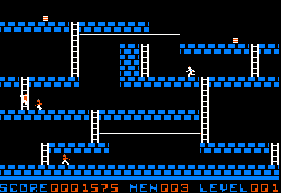 Lode Runner, a game many of us logged hundreds of hours upon. Lode Runner has a great deal of replay value thanks to its great map editor. The game was first published by Broderbund in 1983, but was first prototyped by Douglas Smith, an architecture student at the University of Washington.
Lode Runner, a game many of us logged hundreds of hours upon. Lode Runner has a great deal of replay value thanks to its great map editor. The game was first published by Broderbund in 1983, but was first prototyped by Douglas Smith, an architecture student at the University of Washington.
The Lode Runner prototype was called Kong and was originally written for a Prime Computer 550 minicomputer on campus, but shortly after it was ported to the VAX minicomputer. Originally programmed in FORTRAN and utilized only ASCII character graphics (the most basic of characters).
In September of 1982 Smith was able to port it to the Apple II+ (in assembly language) and renamed it to Miner. In October of that same year he submitted a rough copy to Broderbund and he’s said to have received a one-line rejection letter, “Sorry, your game doesn’t fit into our product line; please feel free to submit future products.”
The original title had no joystick support and was developed in full black and white…not exactly exciting. So, Smith then borrowed money to purchase a color monitor and joystick and continued to improve the game. Around Christmas of 1982, he submitted the game, now renamed Lode Runner, to four publishers and quickly received offers from all four: Sierra, Sirius, Synergistic, and Brøderbund.
The game was released in mid-1983 on the Apple II, Commodore 64 and Sinclair Spectrum and Microsoft’s MSX computer. Of course, later we’d see them on the Atari, NES, Windows 3.1, Macintosh (where I first played it) and the original Green Screened Gameboy.
Levels feature a multi-story, brick platform motif, with ladders and suspended hand-to-hand bars that offer multiple ways to travel throughout. The player can dig holes into floors to temporarily trap robots and may safely walk atop trapped robots. Over time, floors dug into will regenerate, filling in these holes. A trapped robot who cannot escape a hole before it fills is consumed, immediately respawning in a random location at the top of the level. Floors may also contain trapdoors, through which the player and robots will fall, and bedrock, through which the player cannot dig.” (wikipedia)
What did this game do for the industry?
This game offered the industry something new in terms of replay by offering a level editor for gamers to developer their own levels. Once you’ve burned through 150 levels (or prior if you want), you could break open the editor and challenge your friends (and yourself) to new creative levels out of your own imagination.
Back in the early 80’s having a level editor was crazy, considering they probably didn’t even have them for developers to build levels at that point in time. Although ID Software would build internal level editors, later released to the public, it wasn’t for years to come.
Game level editors were something we see now from time to time and everytime a new game is released with a level editor we see its lifetime expanded for years. Today, we just call it “modding,” “conversions” or “total conversions” of a game system much like Half-Life and Counter Strike or any of the thousand mods you can get in games like DOOM, Quake and many top rated FPS style games. Some games, like Dungeon Keeper, are themselves a full game of level editing. Halo 3 has an internal game editor to assist in bringing new content to the world without the need of developers to step in and regulate.
What did this game offer gamers?
Besides a cool game with 150 stages of play, it offered users the ability to develop their own stages as we’ve said. However, it offered them an EASY way to design levels–it’s not so hard to toss a pile of crap to the user community and have them design games without a clue, but to offer an easy way of doing it means you’ll end up with more common gamers taking advantage of the level style.
Proof is in the pudding, gamespot rated Lode Runner “Greatest Games of All Time” list, the first game of many to make its list.
Does this game deserve a remake?
Lode Runner is a classic, with many remakes already. In January of 2008, an Xbox Live version of this game was announced (at CES) and will feature revamped HD graphics and full multiplayer support with leaderboards and such. Although no game editor was announced the main menu has a “downloadable content” button so it’s presumed such might become available (if not at release).
Hudson Soft released Lode Runner on the DS in 2006 and many other sequels have been designed for the game. Lode Runner is simple enough yet creative enough to rebuild for many game devices and remakes with better graphics can only revive the title to our younger audiences.
It’s one of those games that you really would have a hard time not loving. Hear all our commentary on Lode Runner in Episode 60 of the TD Gaming Podcast.
Podcast: Play in new window | Download

 Longest Pre-Order
Longest Pre-Order